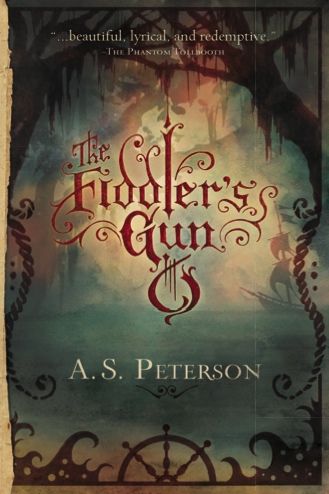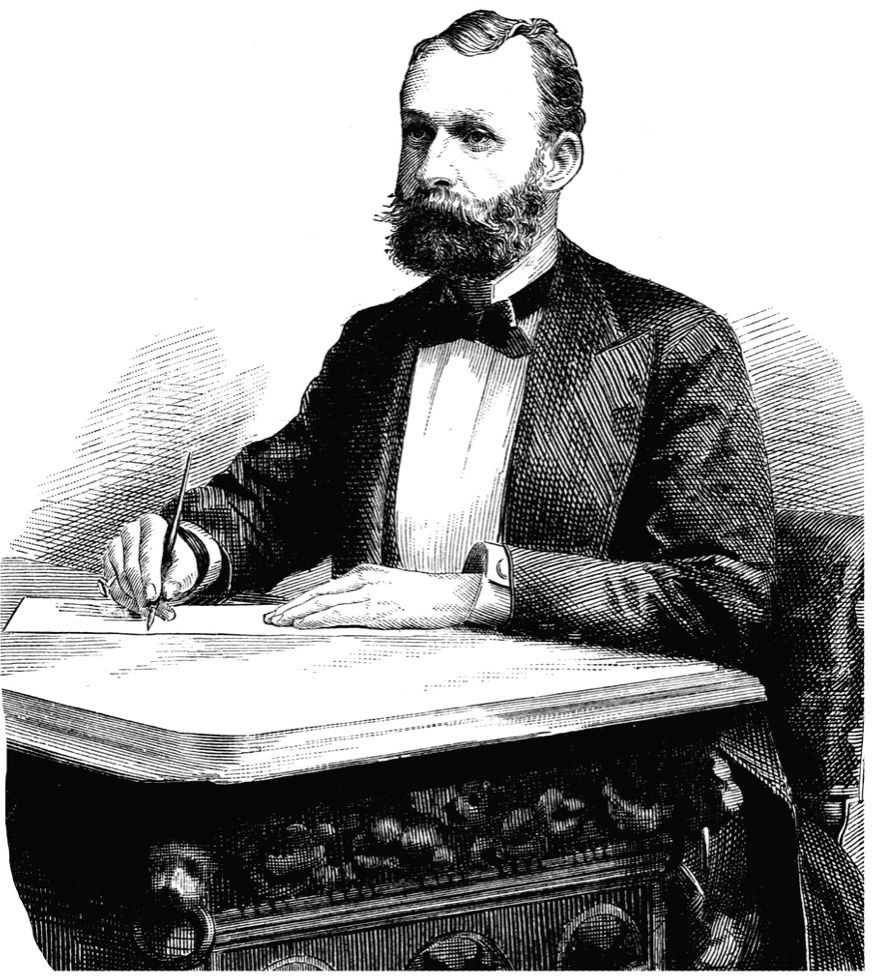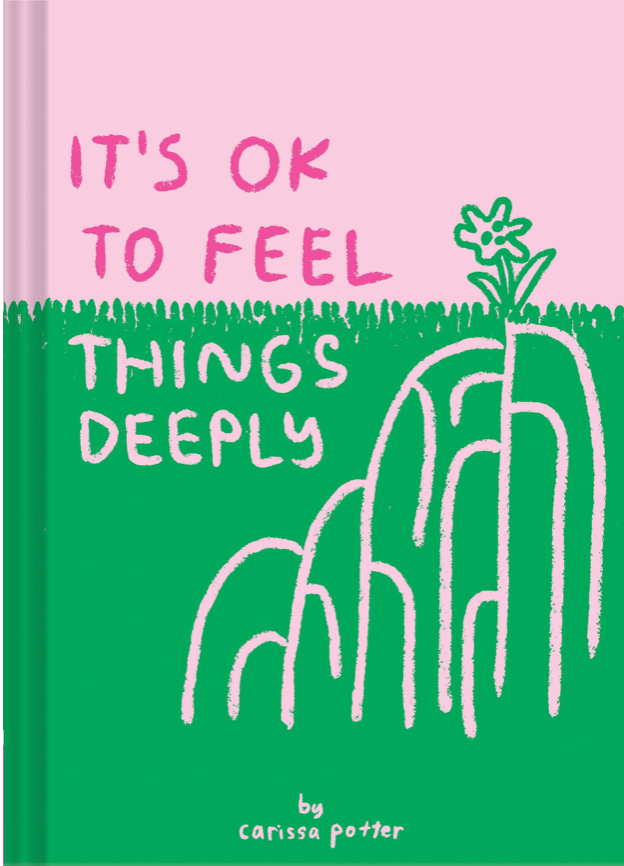I’ve lately been reading all manner of goodness on The Rabbit Room. The blog’s title is a nod to The Eagle and Child pub where the Inklings met to discuss their writings, drink beer, and be merry. As a rabid Tolkien and C.S. Lewis fan, I was sold on the virtual concept immediately. I geeked out further when I discovered that The Rabbit Room’s proprietor was none other than singer/songwriter and authorAndrew Peterson, and contributors included his brother, Pete, Eric Peters, Randall Goodgame, Ron Block, and several creative others. If I have repeatedly insisted that you read Peace Like a River by Leif Enger, well, you have Curt McLey to thank for that.
As I followed these folks’ artistic insightfulness, I discovered that their personal talents crisscrossed between genres – music, books, visual art, pastoring, and so on. Pete Peterson is”a film aficionado, book-lover, cheese-maker, sandwich critic, chair-sitter,” and the author of the forthcoming novelThe Fiddler’s Gun (December 1, 2009). But the book’s cover lists the author’s name as A.S. Peterson. Confused? Pete/A.S. explains, “I grew up going by ‘Sherman,’ which I never much cared for. You can probably imagine how well that went down in school. So after high school, I joined the Marine Corps and there ‘Peterson’ got shortened to ‘Pete.’ . . . I think ‘Pete Peterson’ would look silly on a book cover, so I use ‘A.S.’ instead.”
The book’s main character, Fin Button, came to life in Peterson’s cinematic imagination several Christmases ago when he had the genius idea of building treasure chests of gifts to bury on his parents’ farm, drawing a map for each family member, and making them hunt down their treasure and dig it up. One recipient was to come across a grave marker in the woods bearing the name “Phineas Button,” but Peterson accidentally carved “Phinea.” ” Initially, I thought I’d have to start over and recarve it, but the more I thought about it, the more I liked the way that leaving the ‘s’ off made the name feminine. So I kept it and for the rest of the season I wondered who Phinea might have been and how she came to be buried there and what stories she might have to tell,” said Peterson.
Such a sudden genesis of a fictional character gives me goosebumps. As with all my favorite books, Fin is yet another legendary character that began to live and breathe in the room where I sat and flipped page after page – from the minute she was born on September 25, 1755, to her growing up into a redheaded tomboy at the Ebenezer orphanage.
The Buttons left behind a bundle of red curls and unwanted promise, and Matilda-Mae uttered a silent prayer that her thirteenth baby girl would somehow know a full life in spite of her unkind beginnings. The Baab sisters of the Ebenezer orphanage were ready and willing to answer that prayer and see it through, but time has a way of leading a person along a crooked path. Sometimes the path is hard to hold to and people fall off along the way. They curse the road for its steep grades and muddy ruts and settle themselves in hinterlands of thorn and sorrow, never knowing or dreaming that the road meant all along to lead them home. Some call that road a tragedy and lose themselves along it. Others, those that see it home, call it an adventure.
The poetic rhythm of that paragraph hooked me line and sinker, with all its heartaching, foreboding beauty. I jumped in Fin’s corner, rallying for hope and redemption through her many adventures to come. I’ve stated before that I loathe reading most accounts of history – dry textbooks, facts, and such. But the grand scope of reality, I believe, is that we dwell in history framed by a much bigger story written by One greater than us all. Great books like The Fiddler’s Gun give a lifelike voice to historic characters on whose fictional shoulders we stand. We peer into Fin’s story through the eve and eye of The Revolutionary War. There’s her best friend Peter LaMee, her foe Sister Hilde; humor, romance, betrayal, grand ships, swearing sailors, pirates, gallows, Red Coats, Tories, and the hunger for American independence. Though within the epic framework, Fin just craves acceptance and love, to be an orphan no longer – to belong.
She has the endearing, headstrong spunk of Swede Land (Peace Like a River), which sometimes finds her in dire predicaments. As a stubborn female going through difficult times myself, I was heartened by the honesty of this young woman’s suffering, and the merciful shielding from the very worst case scenarios. In the darkness, there was always hope. She learned to do as her friend, the orphanage cook Bartimaeus, often advised, “Beautiful, that’s what you got to do with that hurtin’, you got to turn it beautiful.” And too, a good, tall tale does this for us all, thanks to the author. Peterson made Fin’s pain and peril beautiful with salvific strokes.
As inspiring as the hard work of a writer is, there’s more to it than just a well-written story. With the same spirit of the Americans fighting for independence – for their own name and identity and not Great Britain’s – Peterson resisted writing for just one genre or age group. The Fiddler’s Gun is historic, but not historic fiction per se. Along with the adventure, it’s literary, and resembles a young adult novel until the point where Fin is forced to mature for survival. The story quickly grows with her right before the reader’s eyes.
Peterson waded through the query submission process, nearly drowning in sixty rejections before finally finding an agent who submitted his book to a few of the big names such as Random House and Scholastic. But they all said no. One would think that a novel so versatile to genres and ages would be appealing to publishers, but it isn’t usually so. They want books that are easy to categorize along with the latest bestsellers, whether good writing or wretched. So Peterson faced a lot of rewrites that would make The Fiddler’s Gun more audience specific, but he was afraid he’d alter the voice of Fin’s story in ways he just didn’t like at all.
Living in Nashville, he looked around, inspired by his community, many of whom are independent musicians. They’re often outcasts in the radio-loving recording industry, yet they make it work, excel artistically, and create a loyal, lifetime following. And then it occurred to Peterson that he, too, could go that route; he could publish The Fiddler’s Gun on his own terms. “And if I was going to publish independently, what better book to publish than one that is, at its core, about independence?” he said.
Unlike the myopic process of self-publishing which often produces poor quality, Peterson gleaned wisdom from his peers. For an editor, he hired his friend, Kate Etue, who has an extensive background in professional editing. He formed a writer’s group of people whose skills and mindset he admired and readily took their advice. He had beta readers point out flaws rather than heap praises at his feet. He hired another friend and fellow Rabbit Roomer, Evie Coates, to design the cover artwork.
But the life of a writer always involves solitude. This whole independent publishing process took about a year, and most of that time was spent editing, rewriting, revising, and editing again. Living on a day job’s budget, Peterson also took on the typesetting himself. He had a little background in print design, but even so, this task of designing the book’s interior nearly made his eyes explode as he pondered margin sizes, fonts, font sizes, line spacing, spacing between words, spacing between letters, and so on. Furthermore, he balanced quality and budget and decided on paper with good color and texture, the heaviest cover stock he could afford, and selected a matte-finished cover because well, shiny covers are loathe-worthy. And he went with rough-edged pages to complement the cover depicting dark beauty on a calamitous sea.
Pete’s journey also inspired The Rabbit Room Press, the independent publishing arm of the aforementioned online pub. Their aim is to produce books that readers can trust – the kind of book you can’t help but recommend to everyone you know. Says Peterson, “Branding is something that Pixar has done masterfully in the movie world. I’ll go see a Pixar movie just because Pixar is willing to put their name on it. I trust them. I know their track record. I appreciate the respect they have for the art of storytelling. The book industry needs that type of branding. Dave Eggers and McSweeney’s have done a lot in that area and I hope the Rabbit Room Press will one day be able to claim that kind of trust and discernment.”
But neither Peterson nor The Rabbit Room Press have won the lottery (that I know of), and so he beseeched fellow bibliophiles and good story-fanatics to be patrons of his craft. There were the inspiring Renaissance patrons, of course, but these days, more and more artists are pursuing the patronage option, or at least considering it. Prog band Spock’s Beard and fellow Rabbit Roomer Eric Peters did so with their latest albums. Likewise, Peterson offered two tiers: for patronage of $50, the reader received two signed trade paperbacks of The Fiddler’s Gun, a copy of 100 signed and numbered Letters to Peter Companion, their name printed in the acknowledgments, and priority shipping before December. For patronage of $30, the reader received two signed trade paperbacks of The Fiddler’s Gun and a printed acknowledgement. Now his novel is off to the printer, so he can’t print any more patrons’ names (though he’d love to), but he “considers anyone that offers their support a patron. And believe me, I couldn’t do it without them,” Peterson said.
As one who’d like to publish books myself someday, I find the artful layers of Peterson’s Fiddler’s Gun publishing saga to be inspiring. There are good books released under the big names, but as the publishing industry changes with almost every day, it seems, an author treks on precarious ground. Here we have a book that is a New York Times bestseller’s equal produced in the very fashion of redemption.
Against all odds, Peterson forged through rejection and confining genre labels to create a classic-to-be. He invites us to be a part of his story, Fin’s story, and the age-old story of artistic humanity: ’tis good to give and receive and cultivate good art. And let us write great stories that ring true, and do so independently, if you have the courage of Fin Button.
Click here to download a PDF sample of The Fiddler’s Gun. Then be a good patron and pre-order Peterson’s book here. Fin’s story will be continued in a sequel – The Fiddler’s Green – now in progress. I’m a supportive [impatient] patron myself.




